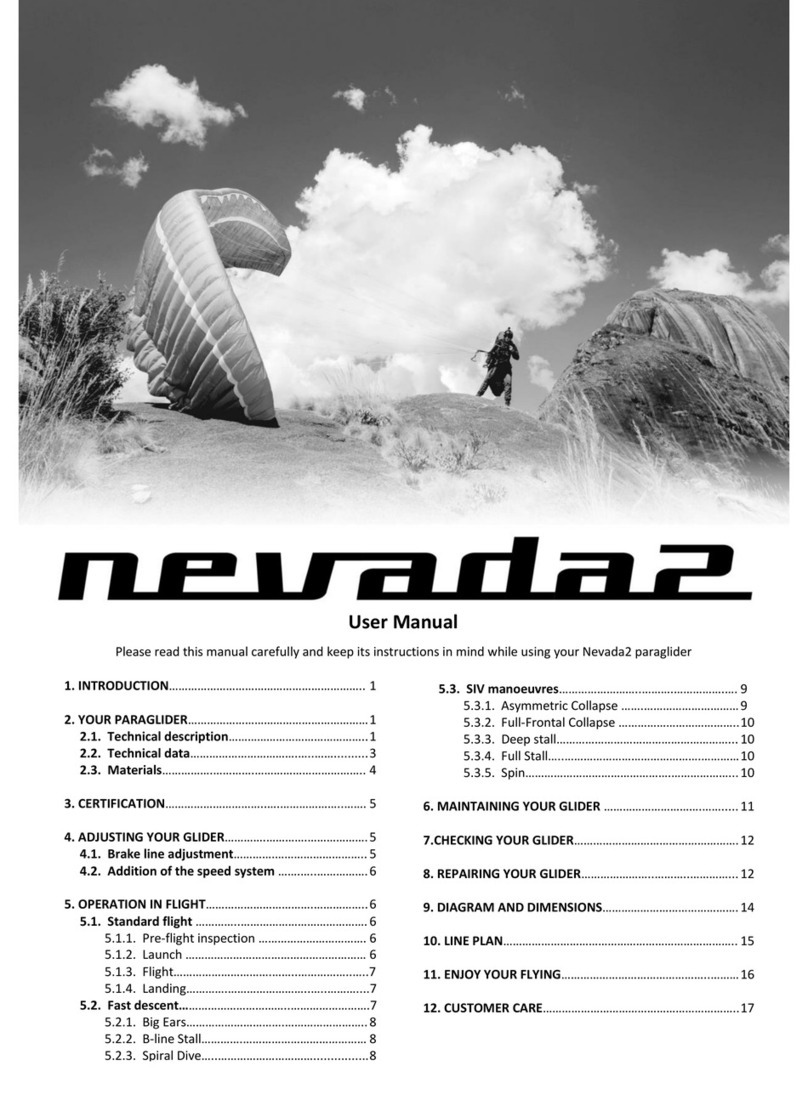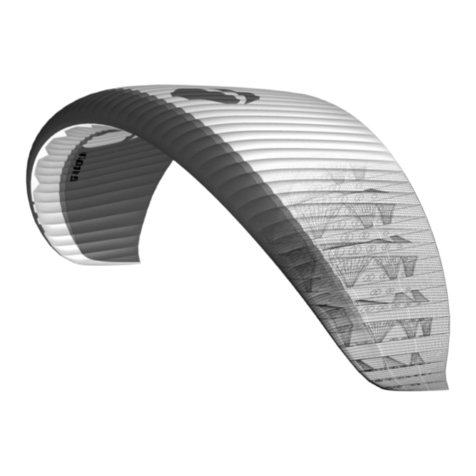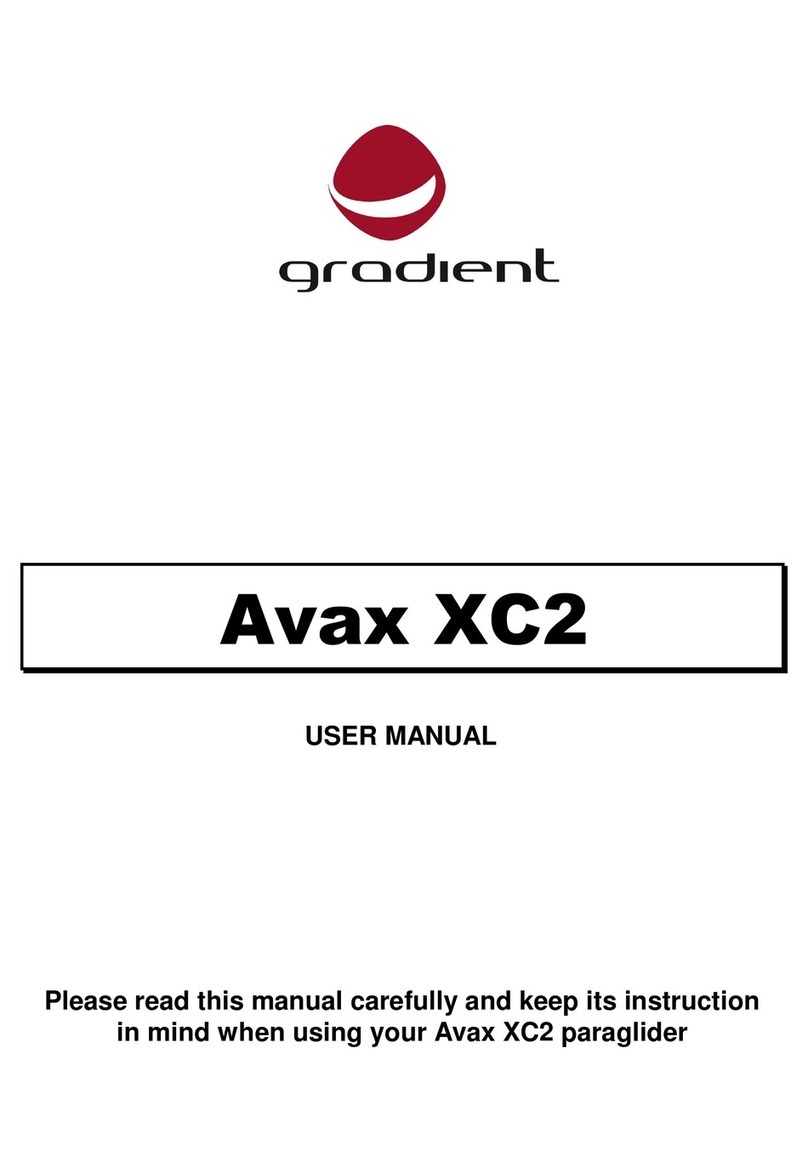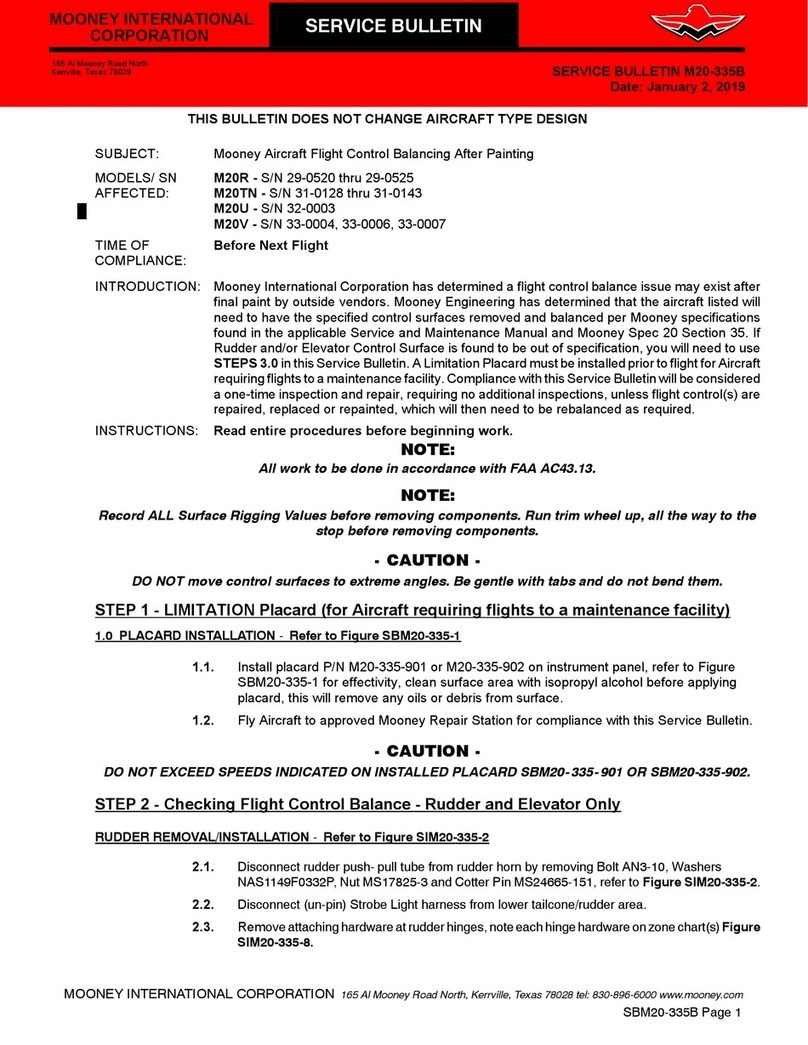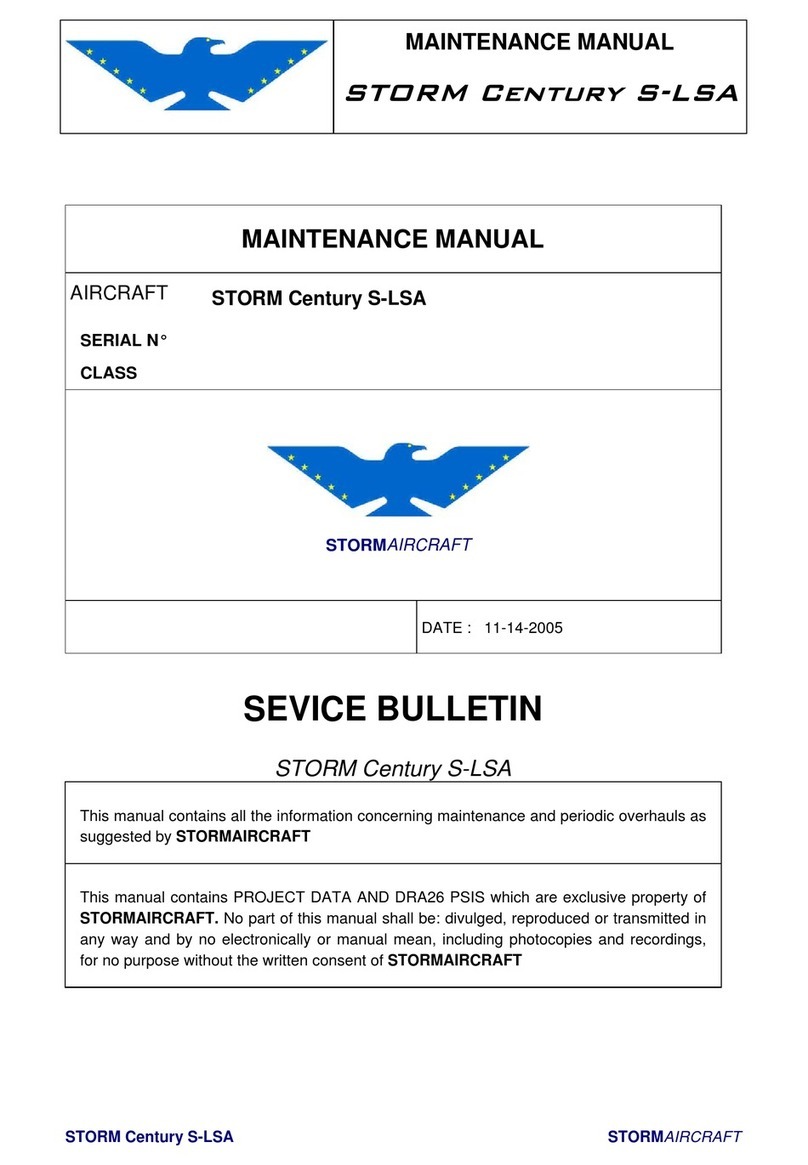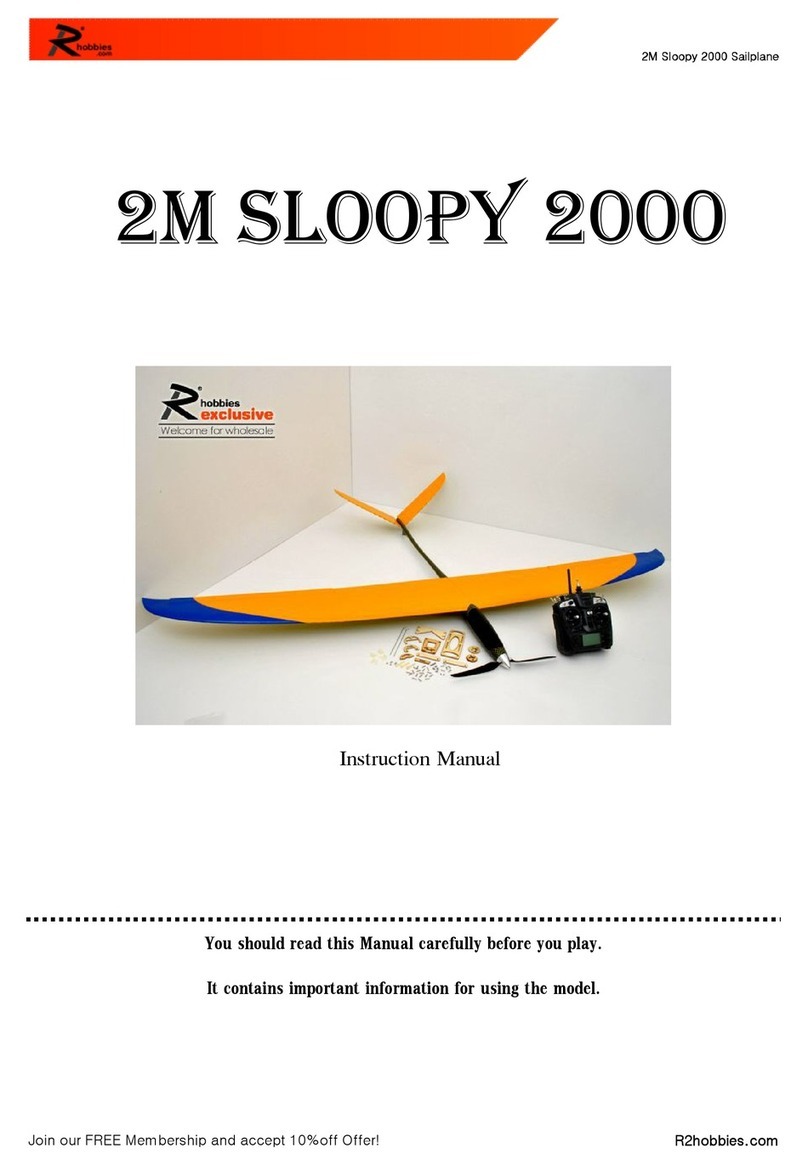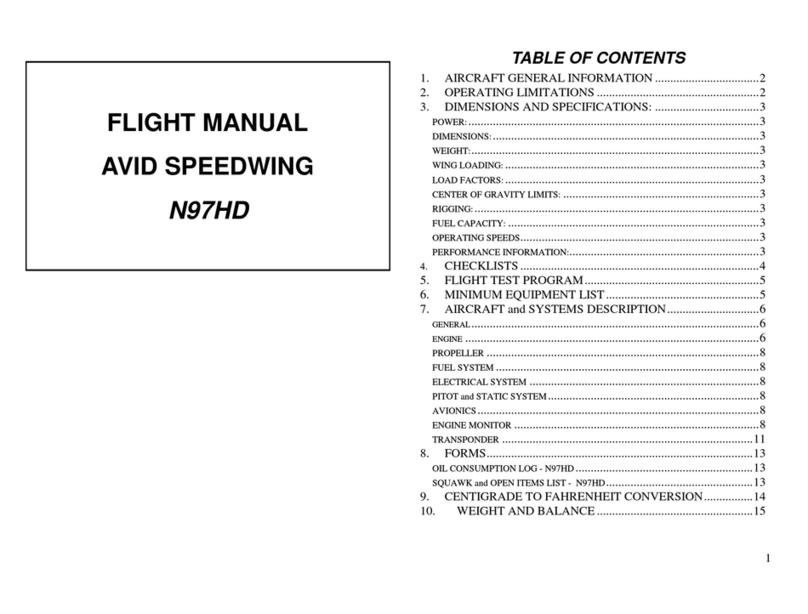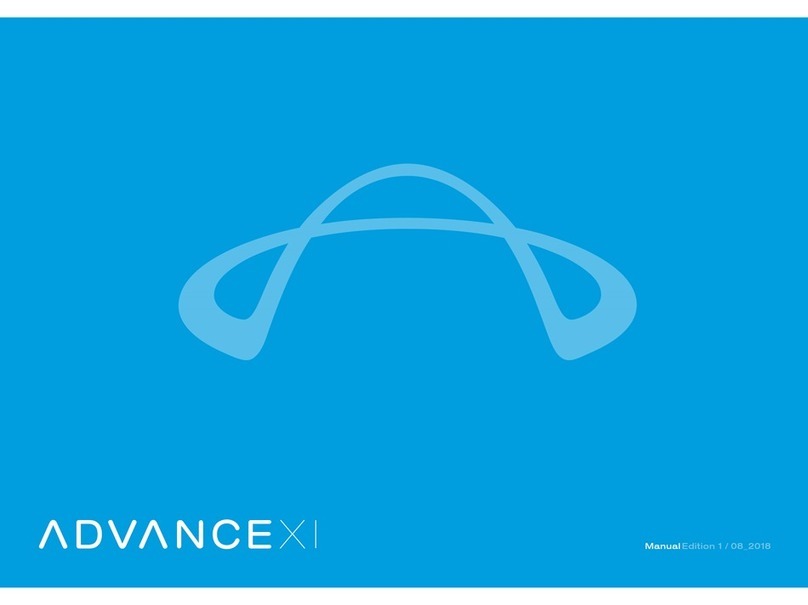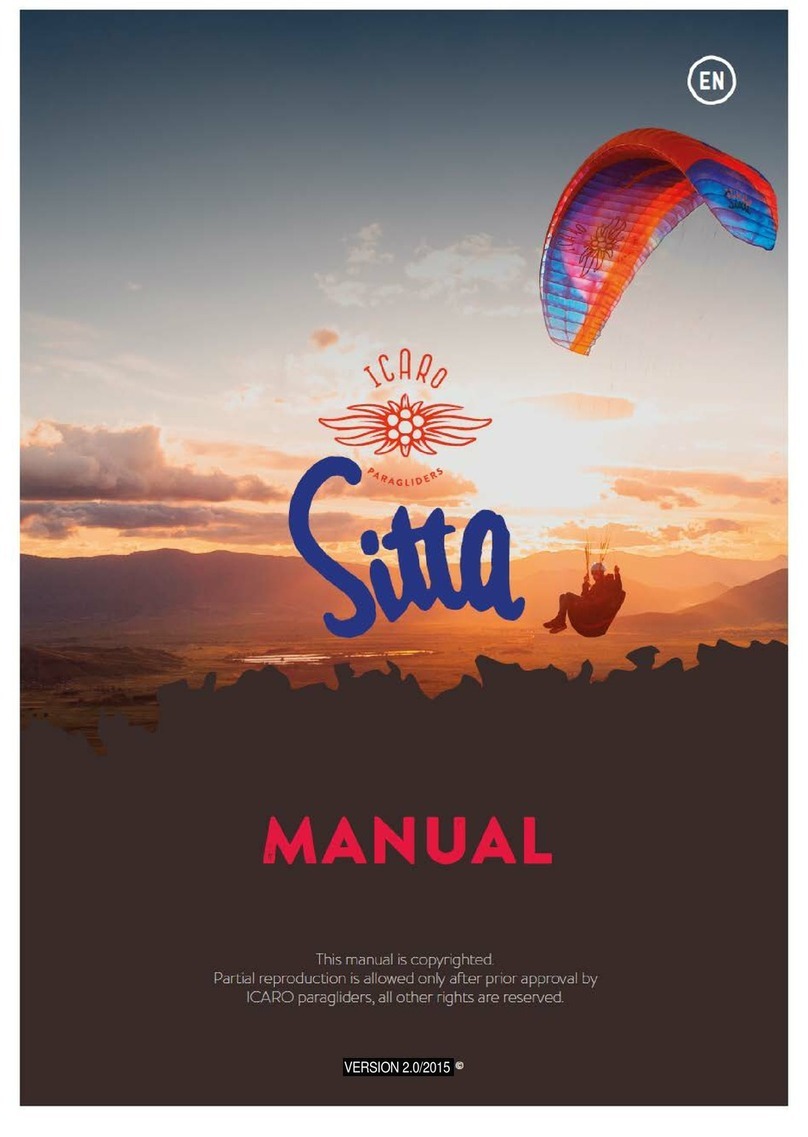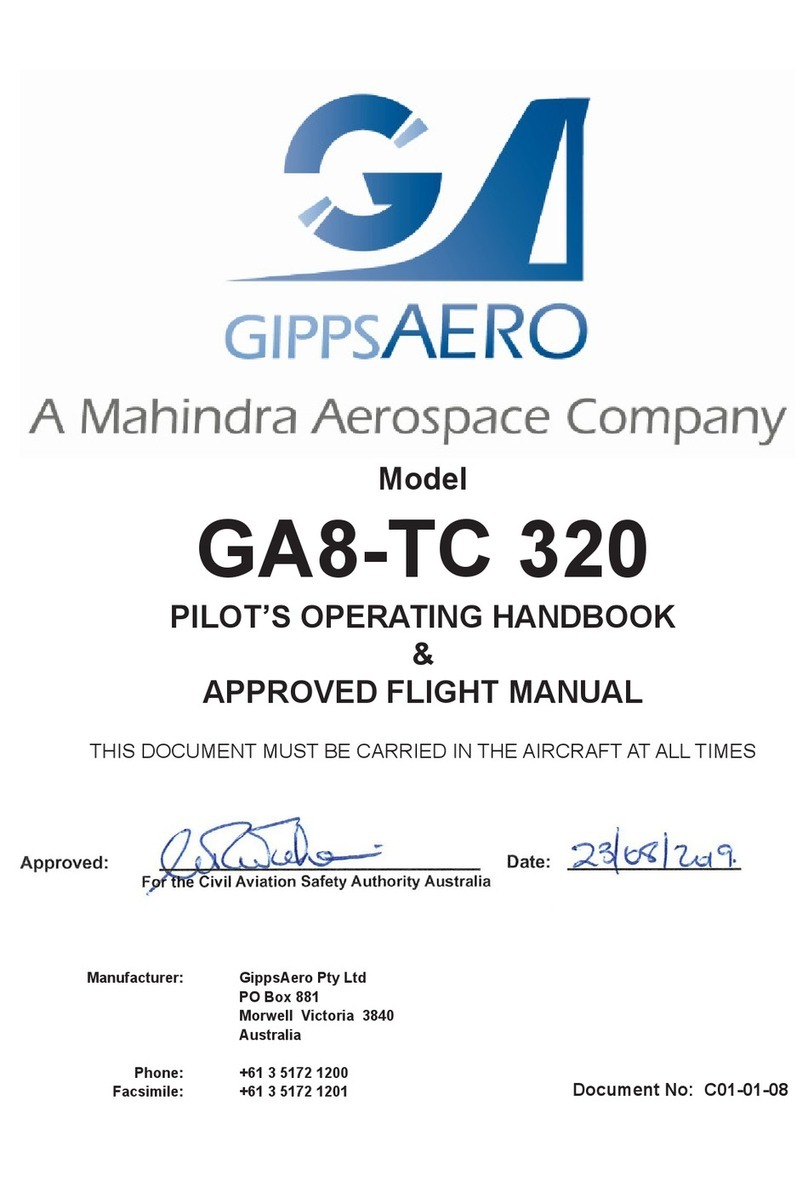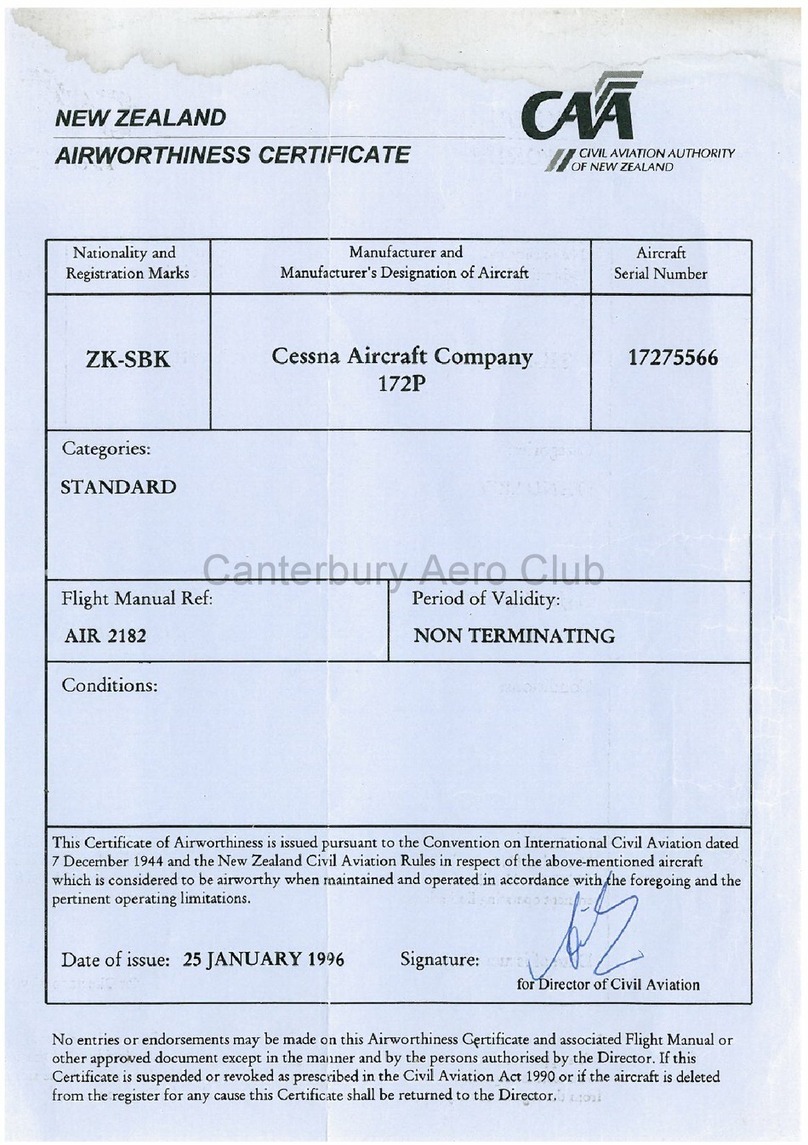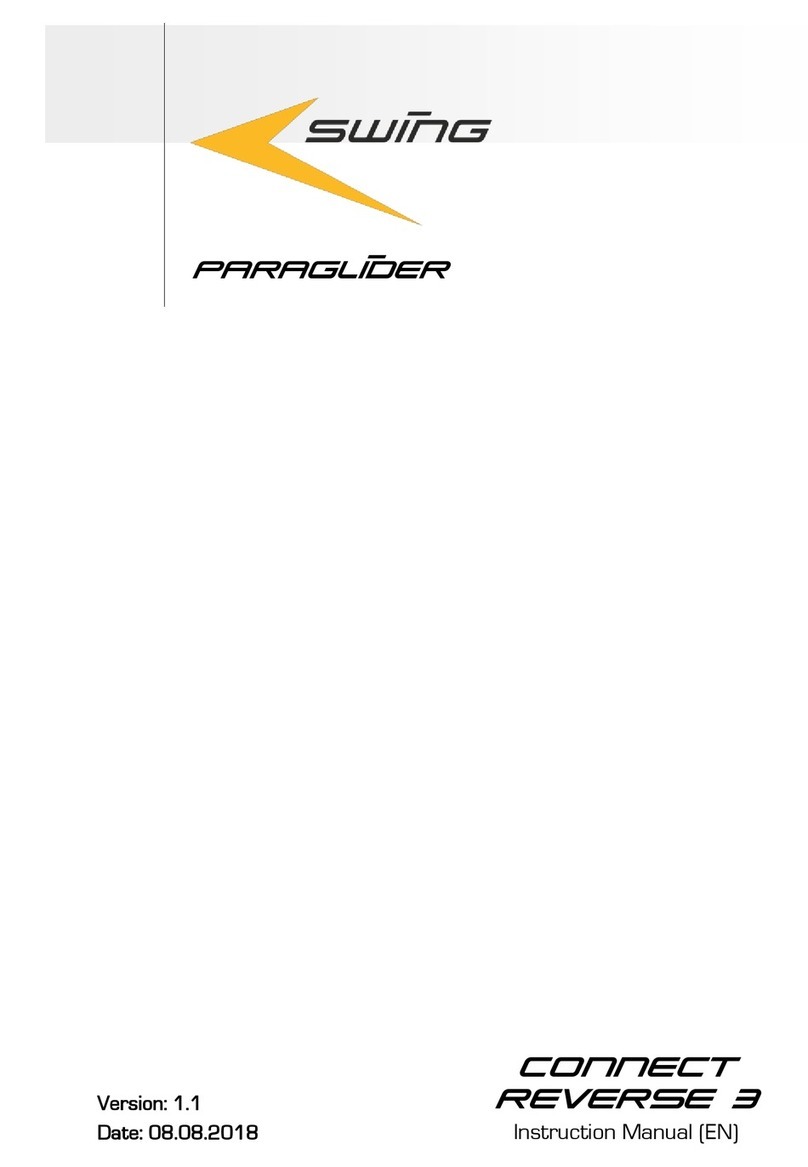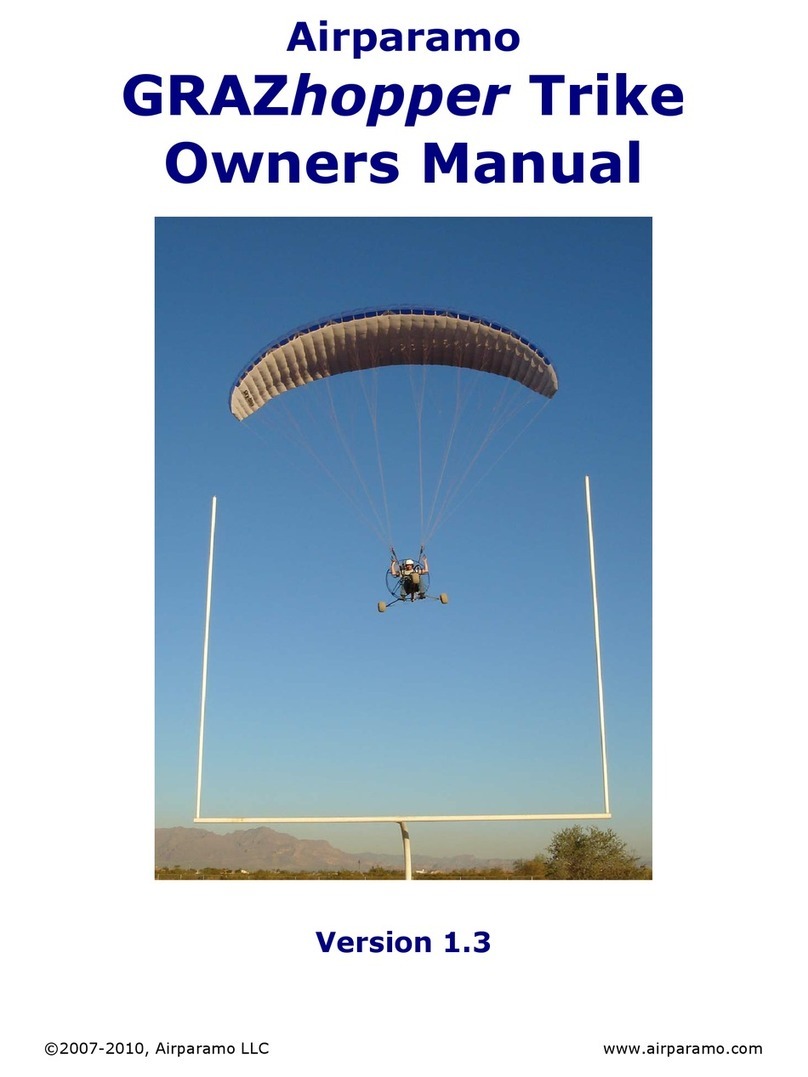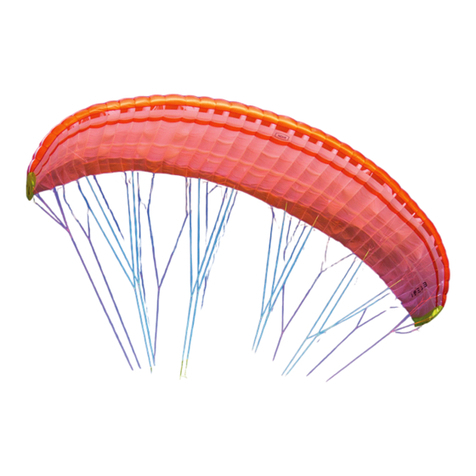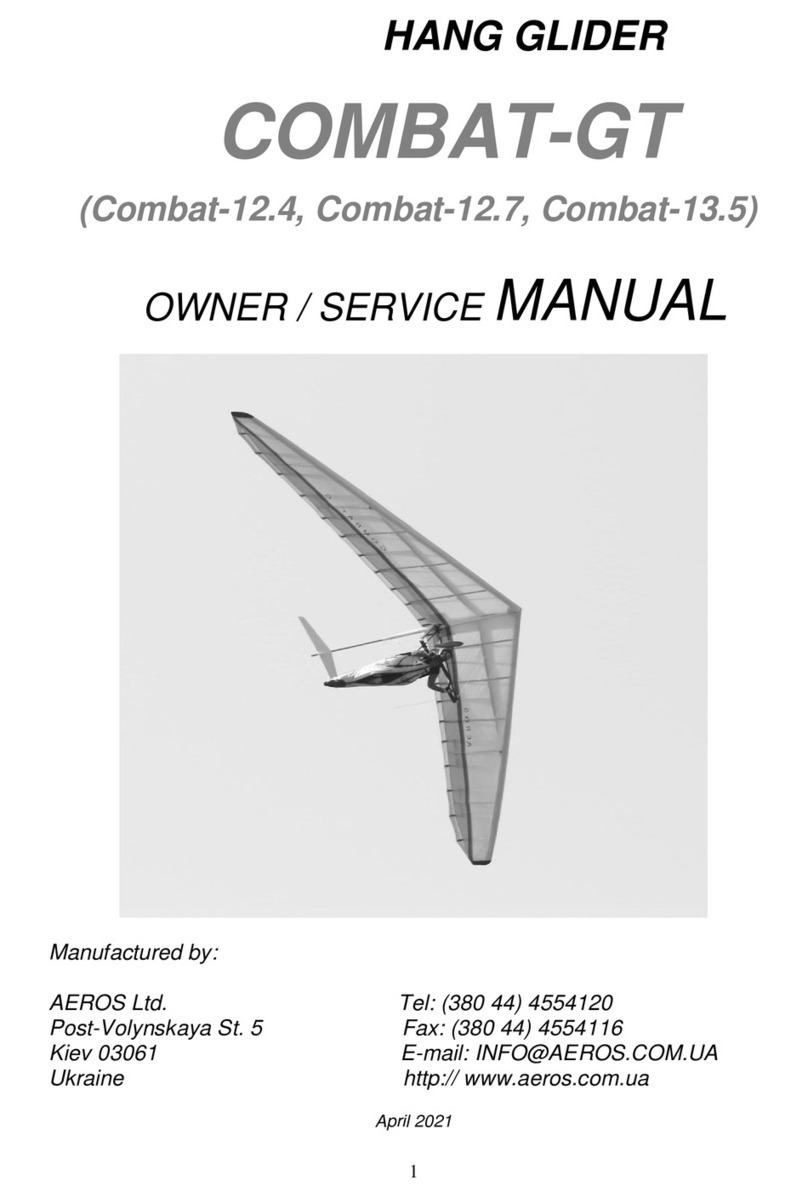Gradient GO Series User manual

User Manual
Please read this manual carefully and keep its instructions in mind while using your Go paraglider
1. INTRODUCTION ...................................................................................................................................1
2. YOUR PARAGLIDER ..............................................................................................................................1
2.1. Technical description....................................................................................................................1
2.2. Technical data...............................................................................................................................3
2.3. Materials.......................................................................................................................................4
3. CERTIFICATION ....................................................................................................................................4
4. ADJUSTING YOUR GLIDER....................................................................................................................5
4.1. Brake line adjustment...................................................................................................................5
4.2. Addition of the speed system .......................................................................................................5
5. OPERATION IN FLIGHT .........................................................................................................................5
5.1. Standard flight ..............................................................................................................................6
5.2. Fast descent..................................................................................................................................7
5.3. SIV manoeuvres ............................................................................................................................8
6. MAINTAINING YOUR GLIDER ...............................................................................................................9
7. CHECKING YOUR GLIDER....................................................................................................................10
8. REPAIRING YOUR GLIDER...................................................................................................................11
9. DIAGRAM & DIMENSIONS .................................................................................................................12
10. LINE PLAN ........................................................................................................................................13
11. ENJOY YOUR FLYING ........................................................................................................................14
12. CUSTOMER CARE.............................................................................................................................14

1Pilot’s manual for Go Revision 0, 22.7.2019
1. INTRODUCTION
Congratulation on the purchase of your new GRADIENT glider –Go. We believe that you will be amazed
by its exemplary flying behaviour as well as its performance.
Go is the brand new glider designed by Gradient‘s R&D department for beginning pilots. It is meant to
fulfil the needs of paragliding schools as well as occasional pilots. The glider excels in passive safety and
tolerates pilots’ inexperience. It is made of the highest quality materials available in the market to
endure unfriendly handling. Thanks to many years of experience, the design of the wing is smart,
elegant and is noticeable by its smart solutions which deliver long life span of the wing, easy
maintenance and it is very easy to repair in case of damage.
Well-balanced dynamics of the wing, precise handling and clear signalling of an incoming stall
guarantee that the Go will be a very reliable partner to a pilot. Good performance, handling and speed
are balanced with an outstanding level of passive safety. Immediate and sensible responses to piloting
allows any pilot to get used to the wing quickly and easily. Flying with Go is easy-minded and intuitive
so the pilot can fully enjoy the beauty of paragliding and concentrate on important decisions during the
flight.
Go is meant to satisfy the needs of a broad range of pilots. From students in paragliding schools, new
independent pilots to experienced pilots demanding an extremely high level of passive safety.
Go is very simple to inflate, which is a distinguishing feature well known to Gradient pilots all over the
world. During thermalling, Go can execute flat turns even with a small diameter. Thanks to balanced
handling and good responses to weight shifting, the pilot will feel comfortable and safe even in
turbulent conditions.
This manual provides information which will help you to fly safely and to keep your wing in good
condition. If, after reading this booklet, you have any further questions or if you are uncertain about
anything, please do not hesitate to contact Gradient or any authorised Gradient dealer. We will gladly
answer all your questions.
We would be pleased to receive your feedback when you get to know your Go.
2. YOUR PARAGLIDER
2.1. Technical description
The plan of the glider is formed by an ellipse with a rectangular shape in the centre of the wing. The
leading edge is positively curved for maximum stability. The Gradient‘s VO system and some brand new
aerofoils have been used. We have taken advantage of our many years’ experience with the models
Bright and Golden. Maximum thickness, the shape of thickness function and the shape of the camber
line were optimised to get the best possible combination of maximum performance, maximum stability
through the whole range of speed and optimal distribution of forces in lines from the loop on the
canopy. With the right layout of these profiles within the wing, we have constructed a compact wing
with comfortable handling as well as fast reinflation after collapses.
This glider has a unique VO system, which is an improved shape of the cell openings for better inflation
of the wing and for a smoother air flow between the canopy and surroundings. Small rectangular cell
openings for sufficient pressurization during all flight modes and deep V-openings for easy inflation and
leading the air flow to the bottom surface of the canopy. The combination of two cell opening shapes
significantly reduces the aerodynamic drag during flights in turbulent conditions and keeps the air
pressure within the canopy more consistent, especially in rough air.
Thanks to the VO system the nose part of the profile has a smooth shape. The smooth shape of the
canopy delivers aerodynamic cleanness and little aerodynamic drag. Different and complicated types
of the leading edge have a bigger aerodynamic drag.

Pilot’s manual for Go 2
There are nylon rods in the front part of the leading edge which make the leading edge nice, clean and
easy to inflate.
For perfect force distribution from the lines to the canopy we used arch stiffeners in the B and C
attachment points.
The line layout of the glider is in two levels and is compatible with the smart inner layout of the wing.
This allows the wing to have only six attachment points for one side in a row. Thus the result is clear
and easy system of lines which eliminates mistakes before the take off.
The lines are set in a common way of three and half rows (A, B, C + D) and two levels of lines with
decreasing diameters towards to the canopy.
We have used the lines of the highest quality available from the renowned company Edelrid. Lines are
protected by covers with decreasing diameters to lower aerodynamic drag and weight.
Sophisticated combination of the line materials (Dyneema and Aramid) in particular levels of lines can
prolong the right geometry of the glider without any need for corrections. This technology postpones
the necessity of replacing the lines and guarantees that the glider maintains its best features for a long
period of time.
The main C-lines are connected to the carabiners through loops, allowing easier adjustment when your
glider is serviced.
Go is supplied with a well proven three-riser speed-system which gives great maximum speed.
Small, simple details make this glider complete. Gradient has paid attention to details too, including:
clearing holes on the wing tips, split A-riser, mini and micro attachment points on the wing tips and
trailing edge and a new rucksack, an inner bag and a riser bag.

3Pilot’s manual for Go Revision 0, 22.7.2019
2.2. Technical data
GO
units
22
24
26
28
30
Flat Area
[m2]
21.60
23.30
26.00
28.60
31.20
Projected area
[m2]
18.59
20.06
22.40
24.62
26.86
Span
[m]
10.30
10.69
11.12
11.85
12.38
Projected span
[m]
8.22
8.54
8.88
9.46
9.88
Aspect ratio
[1]
4.91
4.91
4.91
4.91
4.91
Projected aspect ratio
[1]
3.63
3.63
3.63
3.63
3.63
Max. chord
[m]
2.58
2.68
2.87
2.97
3.10
Min. chord
[m]
0.89
0.92
0.99
1.02
1.07
Number of cells
38
38
38
38
38
Line consumption1
[m]
250.24
259.25
266.11
286.12
298.63
Weight of the glider
[kg]
4.0
4.2
4.8
5.0
5.3
Take-off weight range2
[kg]
50-70*
60-80
75-100
90-115
95-140
Certification EN/LTF
A*
A
A
A
A
1- Line consumption is the sum of lengths of all lines including brake lines.
2- Take-off weight is the weight of the pilot including equipment and paraglider (approx. 15-25 kg)
*-Expectation
Lengths of the risers:
GO 22
Units
A₁+A₂
B
C
Non-accelerated
[mm]
440
440
443
Fully accelerated
[mm]
355
384
443
GO 24
Units
A₁+A₂
B
C
Non-accelerated
[mm]
460
460
463
Fully accelerated
[mm]
370
401
463
GO 26
Units
A₁+A₂
B
C
Non-accelerated
[mm]
480
480
483
Fully accelerated
[mm]
385
417
483
GO 28
Units
A₁+A₂
B
C
Non-accelerated
[mm]
500
500
503
Fully accelerated
[mm]
400
434
503
GO 30
units
A₁+A₂
B
C
Non-accelerated
[mm]
500
500
503
Fully accelerated
[mm]
400
434
503
Risers are without trimmers.
Length tolerance of risers is +/-5mm.

Pilot’s manual for Go 4
2.3. Materials
Canopy
Upper sail - leading edge
Porcher Marine 9017 Skytex 38, E25 Universal, 38 g/m2
Upper sail - rear parts
Porcher Marine 9017 Skytex 38, E25 Universal, 38 g/m2
Bottom sail
Porcher Marine 9017 Skytex 38, E25 Universal, 38 g/m2
Ribs
Porcher Marine 9017 Skytex 40, E29 Hard, 40 g/m2
Diagonals
Porcher Marine 9017 Skytex 40, E29 Hard, 40 g/m2
Reinforcements
Porcher Marine 6098 Laminated Skytex Film, 120 g/m2
Reinforcements
Porcher Marine 6391 SR-170, 165 g/m2
Reinforcements
Nylon Rod Ø2,00 mm
Suspension lines
Lines-top level
Edelrid Dyneema 7850-160, Ø1,50 mm
Lines-top level
Edelrid Dyneema 7850-130, Ø1,30 mm
Lines-top level
Edelrid Dyneema 7850-100, Ø1,10 mm
Lines-top level
Edelrid Dyneema 7850-080, Ø1,00 mm
Lines-top level
Edelrid Aramid 7343-140, Ø1,30 mm
Lines-bottom level
Edelrid Aramid 7343-280, Ø1,80 mm
Lines-bottom level
Edelrid Aramid 7343-230, Ø1,70 mm
Lines-bottom level
Edelrid Aramid 7343-190, Ø1,50 mm
Brake lines
Lines-top level
Edelrid Dyneema 7850-080, Ø1,00 mm
Lines-middle level
Edelrid Aramid 7343-140, Ø1,30 mm
Lines-bottom level
Edelrid Dyneema A-10/N-300-024, Ø2,50 mm
Risers
Webbing
Mouka Tišnov PAD, 15 mm, 22 mm
Pulleys Speed-system
Austrialpin FL12A
Pulleys Brakes
Riley RM 302
Carabiners
Maillon Rapide MRSI03.5 S12, Maillon Rapide MRDI03.5
3. CERTIFICATION
Go is EN-A and LTF-A certified in all sizes.
The EN/LTF certificate for each Go is located on a rib in the middle of canopy. Certification is valid for
the use with all ABS harnesses. This type of harness allows a certain degree of adjustment to be made
to the length of the waist strap. Between 40cm (TOW < 80kg), 44cm (80kg < TOW < 100kg) and 48cm
(TOW > 100kg) - with regard to size of the glider - is the recommended distance between the carabiners.
In common with all other paragliders, when looser cross-bracing is used while flying the Go, the pilot’s
weight-shift control is greater. The glider is also more sensitive to the movement in the surrounding
air. When cross-bracing is tighter, the pilot feels subjectively more stable, however turning by weight-
shift is less effective.
WARNING: The Go paraglider is only built for hill or tow launching. It is not built to withstand jumping
from a plane, balloon, building or for any jumps where there is a belated opening of the canopy. Use of
subsidiary motor (eg paramotoring) has not been tested by the manufacturer or by any other testing
body.

5Pilot’s manual for Go Revision 0, 22.7.2019
4. ADJUSTING YOUR GLIDER
Before it reaches the customer, every Go goes through a final check and test-flight to verify that its
characteristics and measurements correspond to the manufacturer's specifications. You may only make
adjustments to brake-line lengths or to the speed system of your Go –and only then in keeping with
the recommendations of this manual.
Other adjustments or changes to your Go lead to a loss of guarantee, airworthiness and validity of the
certification. Do not endanger yourself and other pilots by amateur modification. If you have any
suggestions for improvements, let us know and our test-pilots will try out your ideas.
4.1. Brake line adjustment
When you receive your new Go the main brake lines are adjusted to the length set during the
certification test. This length should suit most pilots and is indicated on the main control line (R0.0). It
is of course possible to adjust the brake-line length to suit each pilot's physical build, height of harness
hang points, or style of flying. We recommend that you act wisely when adjusting brake-line length
and change the length in small, successive steps.
If you need to adjust brakes back to the basic position and the marks on the main brake lines are vague,
use the following lengths for relevant size:
Go 22: 180 cm
Go 24: 185 cm
Go 26: 196 cm
Go 28: 205 cm
Go 30: 215 cm
Brake lines that are too short may:
●Lead to fatigue from flying with your hands in an unnatural position.
●Impede recovery from certain unstable manoeuvres.
●Certainly reduce speed range of your glider.
Brake lines that are too long may:
●Hamper pilot’s control during launch.
●Reduce control in extreme flying situations.
●Make it difficult to execute a good flare while landing.
Each brake line should be tied securely to its control handle. Use knots which will guarantee this, for
example, Double Dragon.
4.2. Addition of the speed system
Go is equipped with a very effective foot-operated speed system as standard. Pressure on the foot
stirrup shortens the A and B risers and by this reduces the angle of attack of the canopy. Make sure you
can use the whole range when you attach your speed stirrup. For some pilots this will require the use
of a two-step speed stirrup.
5. OPERATION IN FLIGHT
This manual is intended as a guide to the characteristic features of your new Go paraglider. Under no
circumstances should it be used as a ‘learn-to-fly’ manual for paragliding or as a substitute for a
paragliding training course.

Pilot’s manual for Go 6
5.1. Standard flight
5.1.1. Pre-flight check
Pre-flight check is an essential part of getting ready to fly and that's why you should pay special
attention to it. Check the canopy and the lines for damage, clear the lines of any tangles, check the riser
maillons and speedbar connectors, and don’t forget to check your harness and your reserve parachute.
Before launch spread the canopy out into a slight arc and check that:
●all cell openings are free
●no lines are looped around or under the canopy
●no lines are tangled or have a knot in them
●there are no twigs, grass or other objects entangled in the lines or in the canopy
●the risers are not twisted
●the brake lines run freely through the pulleys
●the knots on the brake handles are secure
●the carabiners on the risers are tightened
5.1.2. Launch
Launching Go is straightforward, either by front launch or by reverse launch. A dynamic pull of the
front risers (A, coloured red) will bring the canopy simply and easily above the pilot's head. The canopy
inflates from the centre equally and smoothly. The Go has no tendency to outrun the pilot and quickly
stabilises above the pilot. Once there, visually check the canopy and the lines before taking off. Take
off can be made easier by a light pull on the brakes.
5.1.3. Flight
Go is trimmed to fly at best glide when the brakes are fully up. Best sink rate is achieved when both
brakes are drawn down evenly to about 10-15% of their range.
Flying in turbulent conditions
When flying through severe turbulence, stabilise the canopy by simultaneously applying a little brake
to both sides. Flying with a little brake applied will also help to prevent deflations and give you more
feedback about what the air is doing and how the glider is reacting. Responding correctly to the
paraglider's movement by means of the brakes and weight shift is known as ‘active flying’. A pilot
demonstrating good active-flying skills will significantly reduce both the number and severity of
collapses he or she experiences.
Turning
Go is very comfortable and pleasant in turns. Handling characteristics are responsive and accurate and
demand no special habits or non-standard procedures. When developing Go, special attention was
devoted to the brake pressure. The result is that brake travel and pressure have been optimised. Brake
pressure is reassuringly progressive. In flight, brakes are firm but responsive and precise and allow
perfect communication with the canopy. You will find that a harness with fairly loose cross-bracing will
help the glider turn. In an emergency (e.g. a broken brake line) the glider can be steered with the rear
risers or by weight shift.
Using the speed system
Maximum speed is one of the strengths of Go. Not only for its absolute value in this certification
category, but above all, for its practical usability, given the high speed-system efficiency and stability at
maximum speed.
Don't forget that any collapse at full speed will be more severe than the same event experienced at
normal trim speed. Always keep both hands on the controls when flying fast in turbulence and be ready
to release the speed system immediately at the first sign of a collapse. Use the speed system very
carefully, or not at all at low altitude.

7Pilot’s manual for Go Revision 0, 22.7.2019
5.1.4. Landing
Landing with Go is very simple and shouldn’t cause any problem. On your first flights you may be
surprised at how well it glides. Take account of this when making your landing approach! Into wind, at
about one metre above the ground pull the brakes down all the way. In nil-wind conditions, or if forced
to make an emergency landing downwind, you may prefer to take a wrap around each control line to
enable a more dynamic flare.
5.2. Fast descent
Sooner or later every pilot will need to descend quickly. It might be because of a sudden and
unexpected change in the weather, reaching cloud base and not wishing to enter cloud, or simply
because you need to finish your flight quickly. Additionally, if landing is thermic, it is often very difficult
to land without using a rapid-descent method. There are three main methods for achieving a rapid
descent and they are: Big Ears, B-Line Stall and Spiral Dive.
Practise these manoeuvres under the supervision of an instructor and with a reserve parachute. Never
compromise your safety.
5.2.1. Big Ears
This is the easiest technique for a rapid descent. Depending on how much of the wing tip you deflate,
3 m/s to 6 m/s sink rate can be achieved.
While in Big Ears your sink rate and forward speed can be further increased by using the speed system.
Go can be steered while Big Ears are in by means of weight shift.
Initiation: Grab the outer A-lines or outer split A-risers on both sides as high as possible and pull them
down smoothly. Hold them firmly. The effective area of the glider is reduced equally on both sides of
the wing. The size of the deflated area depends on how deeply the lines are pulled down (or on the
number of lines pulled –one or two outer lines on both sides). Be sure to pull both sides equally.
Recovery: Under normal circumstances Go will open automatically when the A-lines are released.
Opening may be accelerated by gently pumping the brakes (repeated symmetrical braking on both
sides).
CAUTION: The bigger sink rate of the glider increases the angle of attack. By pushing the speed bar, this
effect is compensated.
5.2.2. B-Line Stall
This is an effective rapid descent technique. Depending on how far the B-risers are pulled down, the
sink rate is between 5 m/s and 8 m/s.
Initiation: Grab the B-risers at the top and smoothly pull them down until the canopy shows a spanwise
crease where the B-lines attach to the sail. Your sink rate will increase considerably while your forward
speed will decrease practically to zero. Don't be startled when the airflow over the top surface is
interrupted and the glider enters a parachutal stall without moving forward. It will soon stabilise above
your head. Stability of the canopy in this manoeuvre can be significantly improved when pulling the
B-risers simultaneously down and outward.
Recovery: On releasing the B-risers Go automatically returns to normal flight without staying in deep
stall or shooting in front of the pilot. Let go of the risers smoothly and symmetrically.
CAUTION: Do everything symmetrically and at the same time. If the B-risers are released unevenly the
canopy can enter a turn. If the risers are released slowly and very unevenly you could enter a spin.
5.2.3. Spiral Dive
The Spiral Dive is the most effective way of making a fast descent. Every pilot should be able to perform
a spiral dive and one day you may need to. In a Spiral Dive always stay aware of your altitude, which

Pilot’s manual for Go 8
decreases very rapidly. The sink rate reached in a Spiral Dive can be more than 16-18 m/s. During the
manoeuvre the pilot and glider will experience strong centrifugal forces. Forces of greater than 3G are
possible –a great strain on the pilot as well as the glider.
Initiation: Smoothly pull on one brake so that the glider goes from a normal 360-degree turn into a
steep turn and from there into a spiral dive. The transition into a spiral dive can be made easier by
weight shifting to the inner side of the turn. Keep an eye on the tension of the brakes all the time:
reduced tension signals an overload of the glider and danger of falling into a negative spin.
Recovery: Go recovers from a Spiral Dive automatically as soon as the brakes are released. Release
them smoothly and always finish a Spiral Dive with safe altitude!
CAUTION:When exiting the Spiral Dive make sure your position in the harness is neutral. Recovery from a
Spiral Dive can be delayed if you are weight shifting to the inner side of the turn.
5.3. SIV manoeuvres
No matter what category of canopy you fly or what level of certification it has, in turbulence or in strong
thermals you may experience all kinds of collapses.
Go behaves comfortably in these situations. Indeed not only does the glider deal with extreme flight
situations automatically, but it also offers –for its category –an above-average degree of safety. Even
so, you must follow all safety rules when practising SIV. Always pay attention to your altitude.
Before performing any SIV manoeuvre remember:
●Practise throwing your reserve on the ground, in a simulator, so that reserve deployment is efficient
and automatic.
●Rapid altitude loss and considerable rotational forces may develop during unstable manoeuvres.
Take account of these factors when throwing your reserve.
5.3.1. Asymmetric Collapse –one side of the canopy collapses
Initiation: Grab the outer A-line on one side and pull it down smoothly. The wing tip will collapse to
form a characteristic Big Ear. The size of the ear depends on the depth to which the lines are pulled.
You can stop any turn tendency by applying the opposite brake and by weight shifting onto the inflated
side of the canopy.
Recovery: Under normal conditions Go will reinflate spontaneously when the pulled lines are released.
Inflation time and loss of altitude can be reduced by suitable piloting. To stop any tendency to turn off
course pull the brake on the inflated side (be careful not to overreact and stall the inflated side) and
weight shift to that side. If the collapse remains then reinflate the collapsed side by ‘pumping’ the brake
on the collapsed side.
CAUTION: It is very important to execute this manoeuvre very carefully. Due to the high compactness
of the leading edge and collapse resistance it is quite difficult to find a right degree of pulling of A-risers
down. This applies particularly to the asymmetric collapse of 75% at full speed!
5.3.2. Full Frontal Collapse
Initiation: Grab both A-risers at the top and pull them down fluently until the leading edge collapses.
Recovery: Recovery time depends on how much of the canopy has collapsed. In normal conditions Go
will recover into normal flight automatically as soon as the front risers are released. Applying the
brakes on both sides simultaneously can help reopen the paraglider.
CAUTION: It is very important to execute this manoeuvre very carefully. Due to the high compactness
of the leading edge it is quite difficult to find a right degree of pulling of A-risers down. If you pull them
down too quickly, a massive collapse could happen!

9Pilot’s manual for Go Revision 0, 22.7.2019
5.3.3. Deep stall
Initiation: Pull both brakes smoothly until the sink rate increases markedly and the forward speed
reaches almost zero. The pull on the brakes should be controlled so that the canopy stays inflated and
doesn't fall back into a full stall.
Notice: Maximum symmetric control travel at maximum weight in flight is greater than 55cm for TOW
up to 80kg, greater than 60cm for TOW up to 100kg and greater than 65cm for TOW greater than 100kg.
Recovery: Go cannot stay in deep stall flight, so after the brakes are released the glider automatically
returns to normal flight. If you need to, you can accelerate recovery by pulling hard on both brakes,
followed by a fast release. Or you can pull lightly on the A-risers.
CAUTION: If you pull too hard on the A-risers you may experience a full frontal collapse.
5.3.4. Full stall
Initiation: Wind the control lines once or twice around your hands and pull both of them down
smoothly. Hold them down until the canopy falls behind the pilot and deforms into a characteristic
crescent shape. Hold your hands firmly (press them underneath the seat) and be careful that you do
not release the brakes prematurely or asymmetrically.
Recovery: Go recovers from a full stall automatically once the brakes are smoothly released. During
correct recovery from a full stall Go shows no extreme tendencies such as diving in front of the pilot. If
the brakes are released prematurely or too quickly there is a possible tendency for the glider to dive
ahead of the pilot. This can be corrected by adequate simultaneous braking on both-sides.
CAUTION: When exiting a Full Stall, if the brakes are released asymmetrically the glider may suffer a
massive asymmetrical collapse followed by a tendency to enter a spin.
5.3.5. Spin
Initiation: Slow down by braking to nearly minimum speed. Then pull a brake on one side all the way
down while simultaneously releasing the brake on the other side. Because the stalled side falls back,
the canopy suffers airflow disruption over one half of the wing which results in a spin and a rapid loss
of altitude.
Recovery: Under normal circumstances Go is capable of recovering from a spin automatically when the
brakes are released.
Caution: In general, when there is a very fast or a long-lasting rotation and when the brakes are released
too quickly, the canopy may shoot in front of the pilot followed by a massive asymmetrical collapse.
Warning: Whenever a paraglider is not in normal flight and airflow is disrupted there is always a rapid
increase in sink rate and therefore a substantial loss of altitude.
Remember: When practising SIV the wrong manoeuvre at the wrong time may change a fairly easy
situation into a dangerous problem. You are also exposing your glider to forces that may damage it.
Practise SIV manoeuvres only under the supervision of an instructor and with a reserve parachute.
6. MAINTAINING YOUR GLIDER
If you handle your glider with care and store it in a suitable place it can last you a very long time. On
the other hand, neglecting maintenance, bad storage and the use of unsuitable cleaning products can
reduce the lifespan of your glider significantly or may even make it dangerous.
You must keep to these rules:
●Choose a suitable area for your launches. Lines caught on roots or rocks lead to unnecessary strain
on the attachment tabs during inflation. Snagging the lines may rip the canopy tissue or damage
lines.

Pilot’s manual for Go 10
●When landing, never let the canopy fall on its leading edge in front of the pilot. The effect of these
forceful collisions and the sudden pressure increase can severely damage the air-resistant coating
of the canopy as well as weaken the ribs and seams.
●Protect the canopy from unnecessary strain. Inconsiderate handling of your glider –pulling it over
grass, soil, sand or rocks –will significantly reduce its lifetime and increase porosity.
●When preparing the paraglider for a launch or when ground handling, be sure not to step on any
of the lines or the canopy.
●Don't tie any unnecessary knots in the lines. Packing methods where special knots are made in the
lines as used on parachutes and reserve parachutes are not suitable for packing the lines used on
paragliders.
●Protect your canopy and lines from unnecessary exposure to sunlight. UV-rays can damage many
parts of a paraglider.
●Try not to pack your glider when wet. If it’s unavoidable then dry it as soon as possible but away
from direct sunlight. Be careful to avoid storing your canopy wet - this is the most common reason
for cloth degradation, and is easily preventable.
●Don't let your glider come into contact with seawater. If it does, rinse the lines, canopy and risers
with fresh water and dry before storing.
●After flight or when storing always use the inner protection sack.
●When storing or during transport make sure your glider isn't exposed to temperatures higher than
50 degrees Celsius.
●Never let the paraglider come into contact with chemicals. Clean the glider with clean lukewarm
water only.
●When packing the glider we recommend concertina folding the reinforced leading edge to avoid
damaging the plastic reinforcements.
●For long-term storage don't pack the glider too tightly. Store it in a cold, dry and well-ventilated
room.
●After tree- or water-landings always examine the glider carefully. If you suspect that the flight
features of your paraglider have changed, contact an authorised Gradient supplier as soon as
possible.
7. CHECKING YOUR GLIDER
After 200 flying hours or two years your Go must be thoroughly checked and tested by the
manufacturer or by a Gradient authorised service centre. This check is primarily focused on:
●measuring of porosity
●measuring of tear strength of fabric
●sewing of panels, attachment points, cell openings, etc.
●condition of lines and risers
●line strength
●geometry of the suspension system
All data are recorded in the test report. On the basis of the wing’s condition, the authorized technician
will define the next check interval: under normal circumstances it is two years.

11 Pilot’s manual for Go Revision 0, 22.7.2019
8. REPAIRING YOUR GLIDER
Only small repairs, that don't change the airworthiness of the paraglider, may be done by the user.
These include: fixing small tears (but not seams) up to 10 cm; changing damaged lines; and changing
rubber line-fixation rings on the small karabiners.
When repairing your paraglider on your own keep to the following rules:
●When repairing the sail use a self-adhesive patch specified for this purpose. Every Go comes with a
small amount of self-adhesive material which is enough for small repairs.
●The only admissible repairs done on lines are those where the damaged lines are changed for new
ones. Lines must be exclusively supplied by Gradient; an authorised dealer or authorised service
centre. When ordering new lines use the codes in the attached line diagram. Use the code ‘G5’ and
size of the glider, followed by the line code. E.g. the outside main line in row A for a Go 28 is: ‘Go
28 A1.3’.
●An exception to this is an emergency repair of brake line while out flying. For this purpose Gradient
encloses a spare line with every Go with a prepared loop on one end. To get the right length adjust
it according to the same line on the opposite side of the canopy. As soon as you can, change the
line for an original one from your authorised Gradient service centre.
●After changing any line a thorough pre-flight check must be done. Don't hesitate to ask your
instructor or an experienced colleague for help. If you're not sure, entrust the job to either the
manufacturer or an authorised Gradient dealer.
If you have to replace any of the line-tidy rings (spare rings are supplied with each Go) check that the
lines haven't been swapped accidentally and that they are returned to the small carabiner in the correct
order.

13 Pilot’s manual for Go Revision 0, 22.7.2019
10. LINE PLAN

Pilot’s manual for Go 14
11. ENJOY YOUR FLYING
Even though Go has outstanding performance and stability, it must be understood that even the safest
paraglider is an aircraft and that all air sports can be relatively dangerous.
Remember that your safety lies in your own hands and that it is always your responsibility to be well
prepared.
Never underestimate weather conditions. And never forget that you are flying for pleasure and not to
become a ‘fallen hero’. Remember this and the fun that only free-flying can bring will be yours.
We believe that your sensible attitude and the flight characteristics of your Go will combine to ensure
you have many hours of fantastic flying.
For all our gliders we use Porcher materials which are made under environmental laws of the EU and
all the coating is environmentally friendly.
When your glider gets to the end of its life we recommend to use Porcher recycling Program to dispose
it.
GRADIENT wishes you many fabulous flights and happy landings.
Lukáš Pohl Théo de Blic
R&D team - designer R&D team –test pilot
12. CUSTOMER CARE
Please contact your nearest Gradient dealer for any questions concerning your Gradient
equipment.
You can find the list of all Gradient dealers on our website.
http://www.gradient.cx/en/Agencies
Our production and development centre is located in the Czech Republic
Gradient s.r.o.
Plaská 622/3, 150 00 Praha5, Czech Republic
www.gradient-gliders.com
This manual suits for next models
5
Table of contents
Other Gradient Aircraft manuals
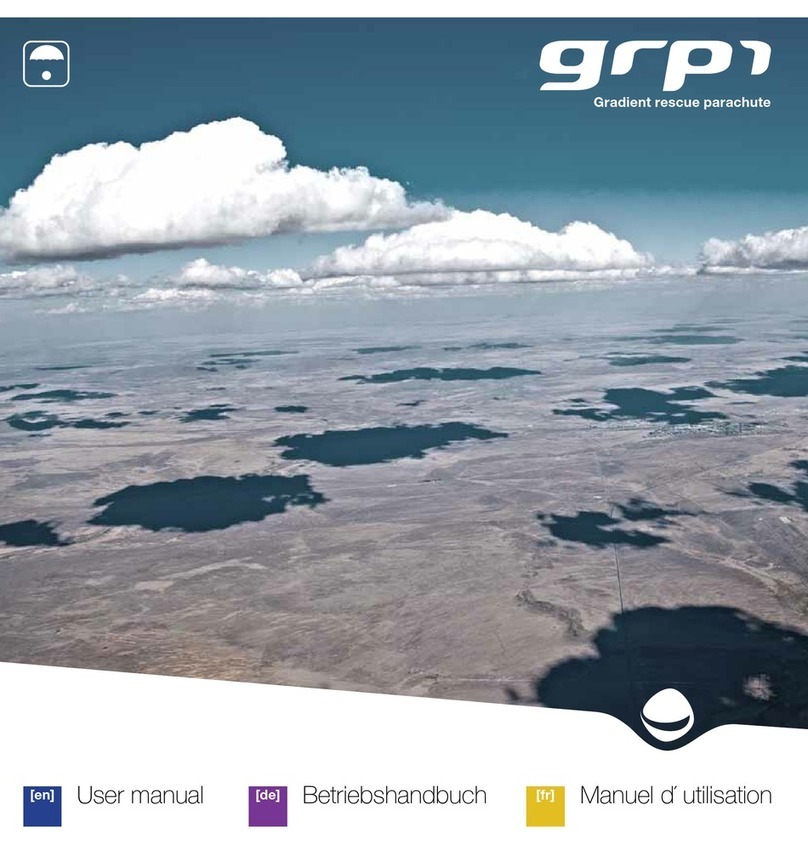
Gradient
Gradient GRP1 Installation and operation manual

Gradient
Gradient BRIGHT III User manual
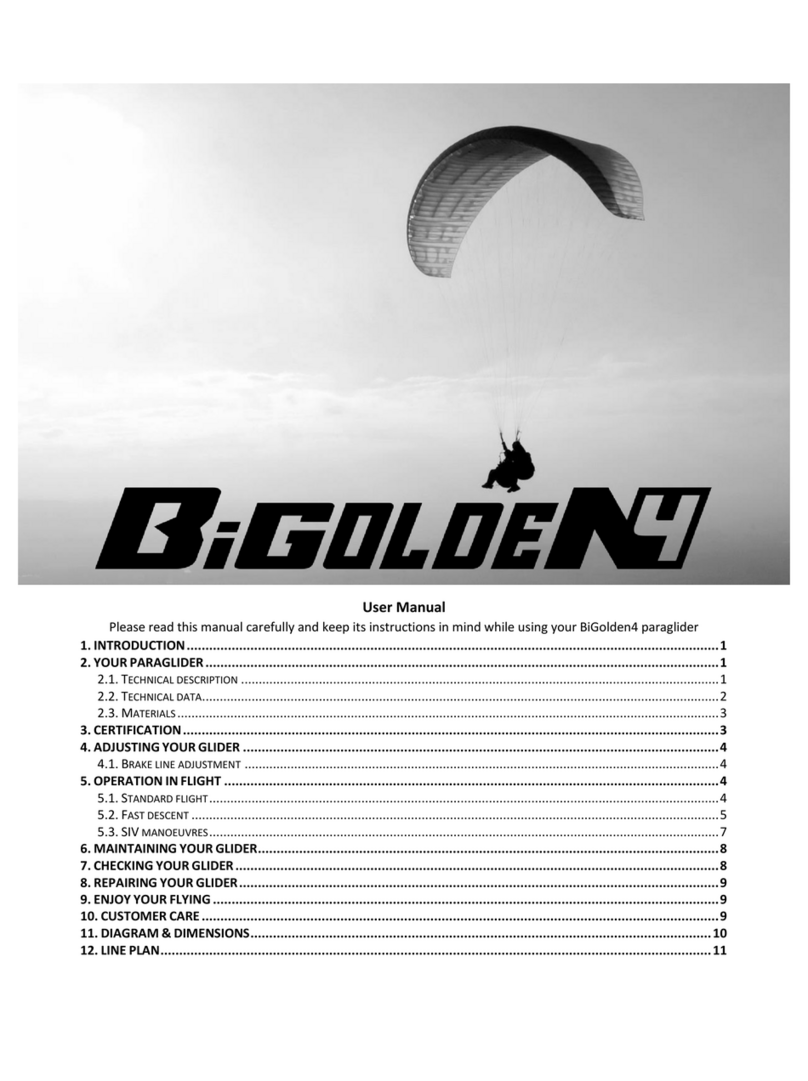
Gradient
Gradient BiGolden4 User manual

Gradient
Gradient BiGolden2 38 User manual

Gradient
Gradient Aspen5 User manual
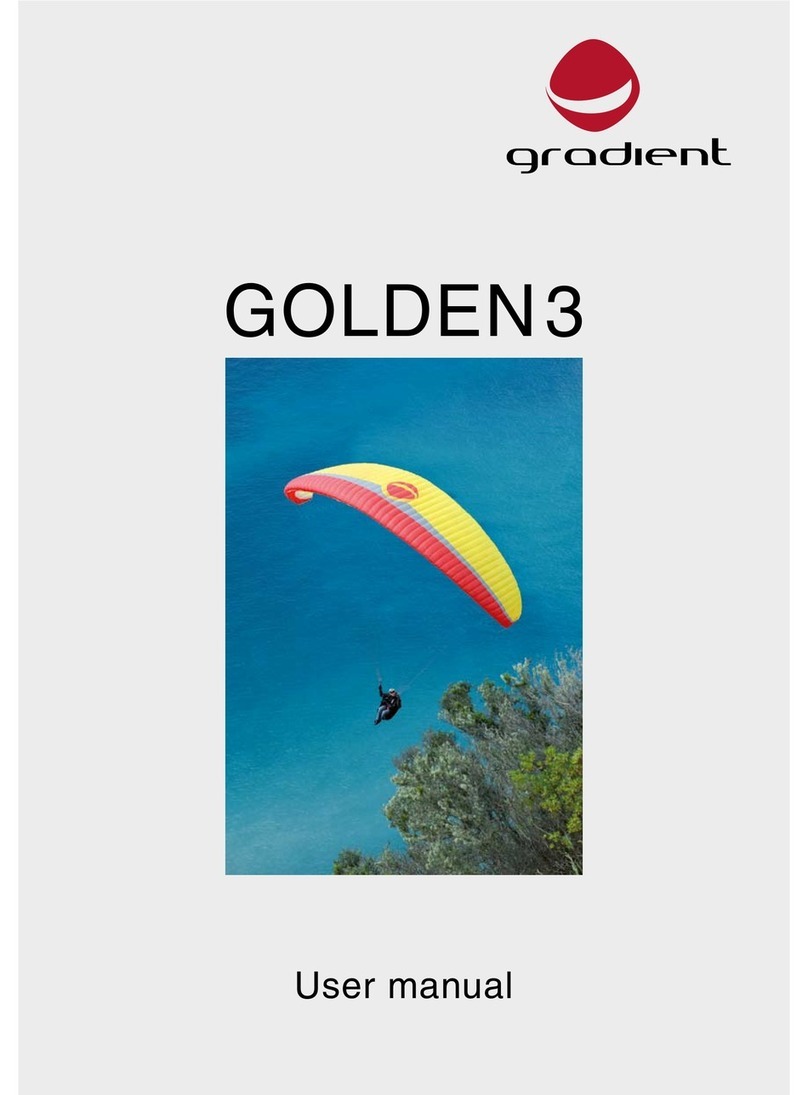
Gradient
Gradient GOLDEN3 User manual
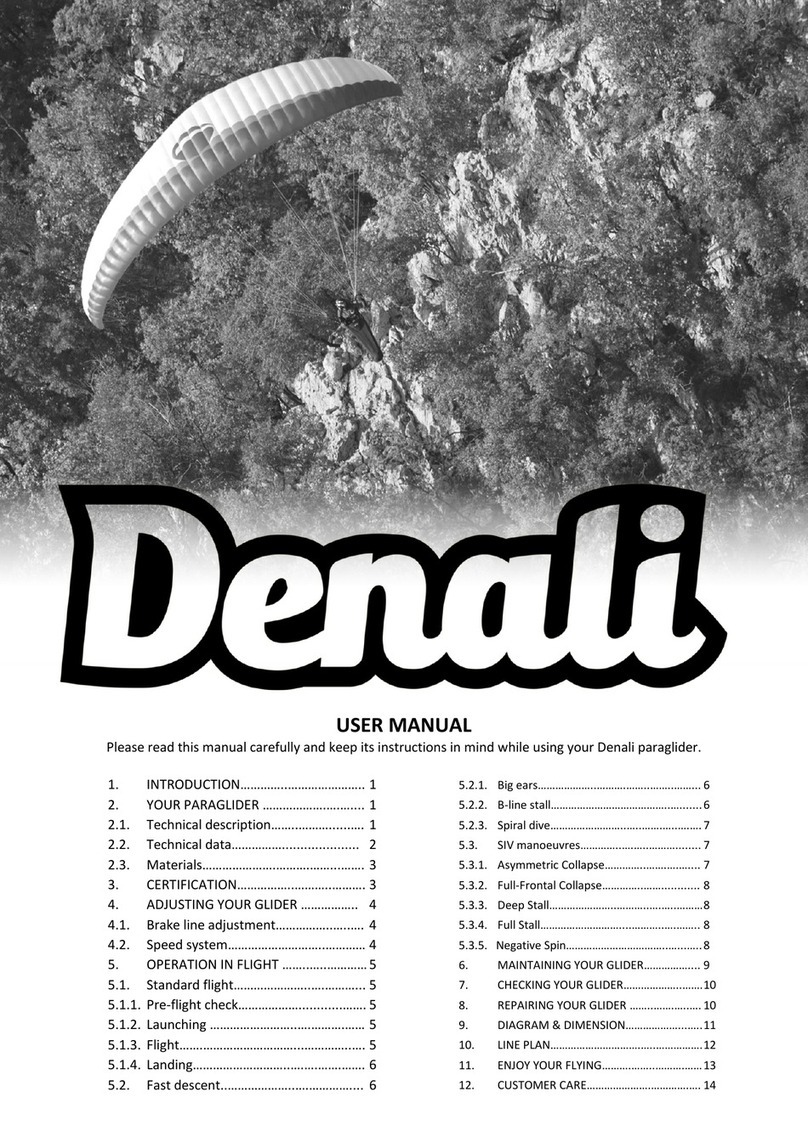
Gradient
Gradient Denali User manual
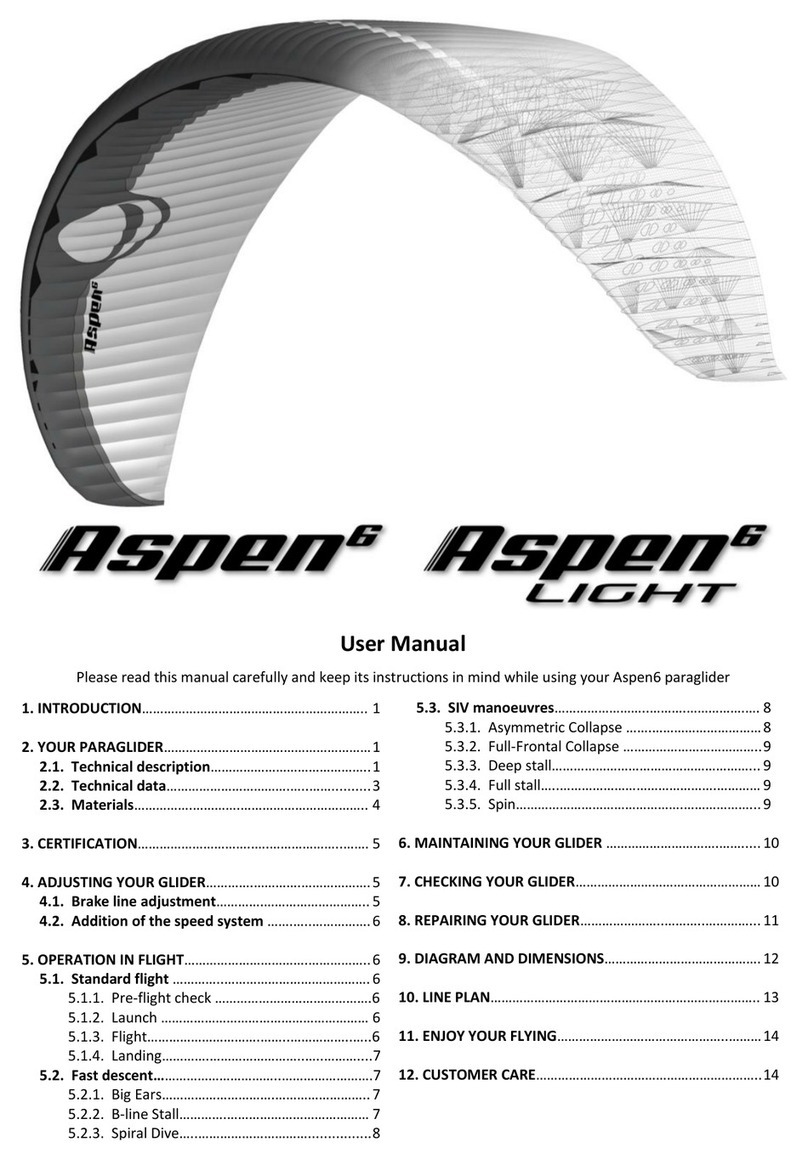
Gradient
Gradient Aspen 6 User manual
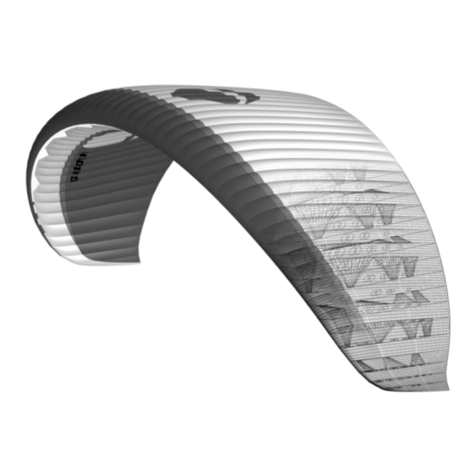
Gradient
Gradient Golden5 User manual
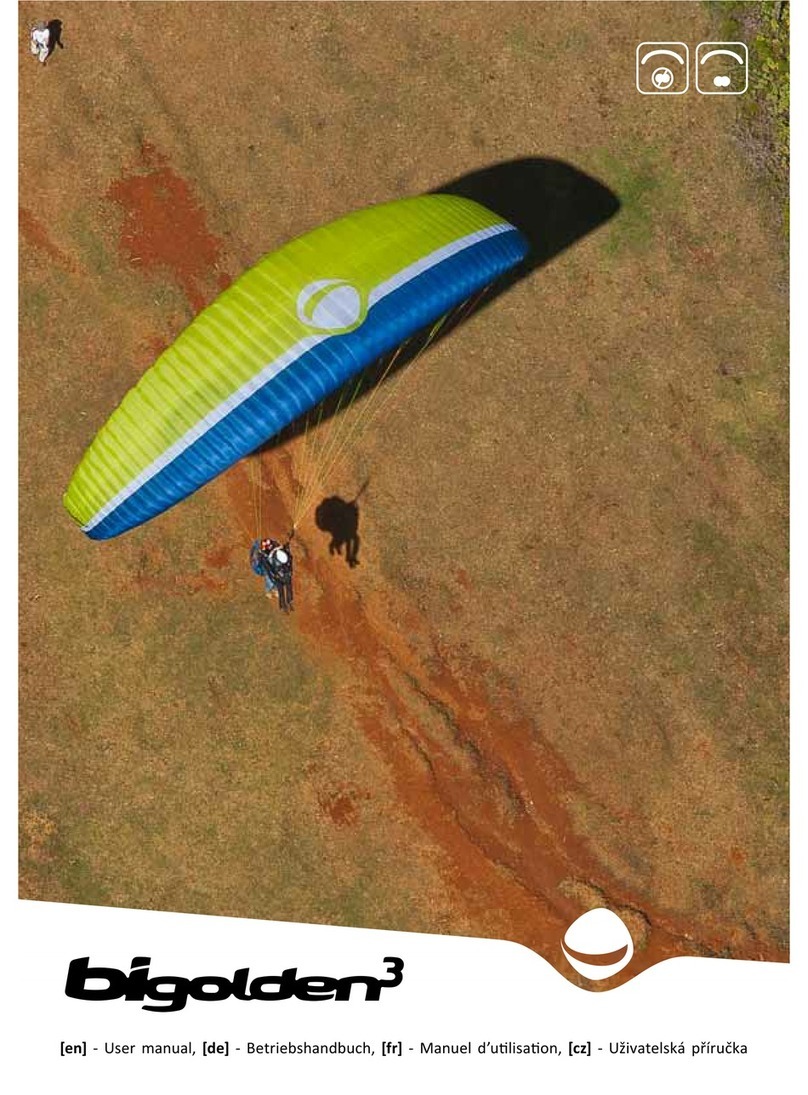
Gradient
Gradient bigoldern3 User manual


